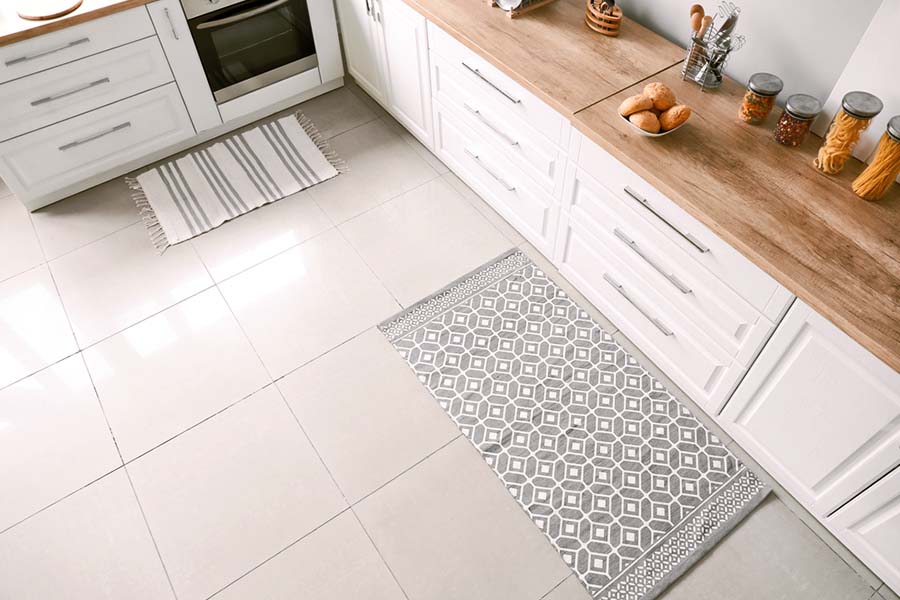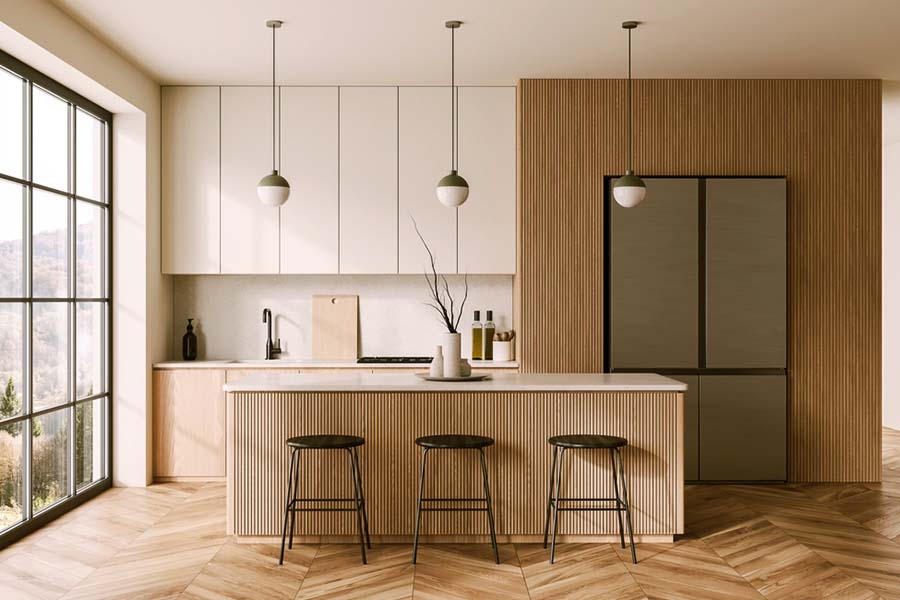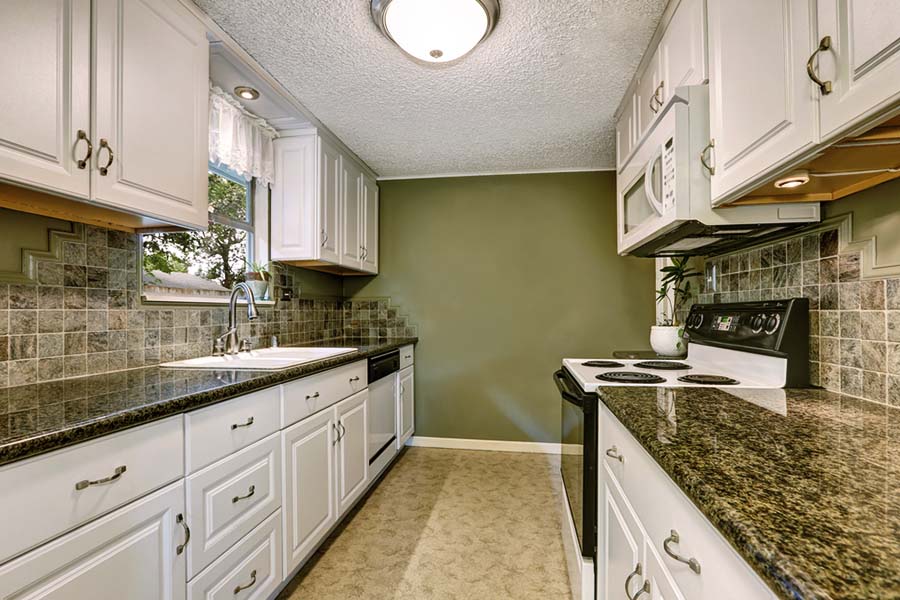What Is the Best Flooring for a Kitchen?

The kitchen is one of the highest-traffic areas in any home, subjected to spills, heavy foot traffic, and potential moisture issues. So, choosing the right flooring for your kitchen is crucial. But with so many options available, what is the best flooring for a kitchen?
Whether you prioritize timeless elegance or a budget-friendly solution, this comprehensive guide will explore the top contenders for kitchen flooring. The right kind of flooring will ensure that it will stand the test of time and daily wear and tear.
Buckle up as we dive into kitchen flooring options, uncovering the perfect balance between practicality and style!

What Is the Best Flooring for a Kitchen?
The best kitchen flooring depends on budget, style, and maintenance. Porcelain or ceramic tiles offer durability, water resistance, and design versatility. Vinyl is affordable, water-resistant, and comes in various styles.
Hardwood floors add warmth but require maintenance and are prone to water damage. Laminate is budget-friendly and easy to clean but sensitive to water.
Moreover, natural stone like granite adds luxury but requires sealing and can be costly. So, we will elaborate more in the following sections.
Why Is Kitchen Flooring Important?
The kitchen is always bustling with activities, from cooking and preparing meals to hosting guests. With spills, stains, and lots of walking, the floor gets a lot of wear and tear.
So, picking the right flooring material is important for both practicality and appearance in such a busy area. We elaborate more on its importance in the following:
Spills and stains
Spills in the kitchen happen—it’s just a part of life. These accidents can leave stubborn stains, whether it’s a bit of pasta sauce or a spill of red wine.
That’s why it’s good to choose materials like ceramic tiles or luxury vinyl planks for your kitchen floor. They resist stains and are a breeze to clean, perfect for kitchens with a lot of action.
Heavy traffic
The kitchen gets a lot of foot traffic daily, which puts a lot of strain on the floors. This constant activity can wear down the floors, so they need to be tough.
Hardwood floors look nice, but they can get scratched and dented with all the traffic. On the other hand, tile and luxury vinyl planks are much stronger, withstanding high foot traffic without excessive damage.
Ease of maintenance
Maintaining the kitchen clean and hygienic is crucial. Hence, the type of flooring used greatly impacts how easy it is to maintain cleanliness.
Luxury vinyl planks and tiles are the easiest to maintain, typically requiring only a quick sweep and occasional mop. While tile floors can pose challenges due to grout lines, using epoxy grouts can help minimize this issue.
Comfort
Spending extended periods in the kitchen can tire you out because of standing on hard floors. To feel more comfortable, pick flooring with a bit of cushioning.
Hardwood and laminate floors are tough on your feet, and tiles might feel chilly unless you have underfloor heating. Also, luxury vinyl planks and corks are softer and warmer, making them better choices for standing for a long time.

Key Considerations for Selecting Kitchen Flooring
When choosing flooring for the kitchen, several key factors must be carefully considered to ensure a functional, stylish, and safe space. So, what is good flooring for a kitchen? The following factors will help you answer that very important question:
Durability
Kitchens endure a lot of wear and tear from heavy appliances, constant foot traffic, and daily use. Hence, durable materials like ceramic or porcelain tiles are designed to resist scratches, dents, and damage.
Luxury vinyl planks and engineered hardwood share this durability as well. They can withstand the bustling kitchen environment for years with proper maintenance.
Moisture resistance
Spills and moisture are inevitable hazards in kitchens. Whether it’s a knocked-over glass or a cooking mishap, the flooring must be able to handle moisture without warping, swelling, or staining.
Therefore, luxury vinyl planks and ceramic tiles excel in moisture resistance, allowing for easy cleanup of liquids. Even engineered hardwood, with proper sealing, can offer decent protection.
Aesthetic appeal
While function is paramount, the flooring contributes significantly to the kitchen’s overall aesthetic appeal and ambiance. Hardwood exudes timeless warmth, luxury vinyl planks mimic wood with added durability, and tiles offer sleek, modern, or rustic vibes in various colors and patterns.
Safety
Kitchens can be hazardous areas prone to slips and falls. So, choosing slip-resistant flooring with adequate traction, especially in high-moisture zones, is crucial for safety.
Textured tiles, embossed luxury vinyl planks, and hardwood with specialized finishes provide excellent slip resistance. We must also point out that Prompt cleanup of spills also improves safety.
Budget
Cost is a practical consideration when selecting kitchen flooring. Materials like luxury vinyl planks and laminate are generally budget-friendly.
However, hardwood and tile tend to be more expensive. Installation costs also contribute to the total expense. Long-term maintenance expenses should also factor into the overall budget for a realistic picture.
Types of Best Flooring for a Kitchen
Luxury vinyl flooring
Luxury vinyl planks (LVP) and tiles are among the top contenders for kitchen flooring. They are praised for their outstanding water resistance and durability against spills, moisture, and heavy foot traffic.
LVP and LVT offer a wide array of designs. They can mimic hardwood, tile, and stone, allowing seamless integration into any kitchen aesthetic.

Porcelain and ceramic tile
Porcelain and ceramic tiles have long been kitchen favorites for their excellent water resistance and durability. Their impervious, non-porous surfaces resist moisture, staining, and scratches.
Tiles come in many styles, from classic subway to intricate patterns and textures. They provide sleek, modern, or warm rustic vibes.
Hardwood flooring
Hardwood flooring lends a classic, warm look to kitchens. While solid hardwood is prone to moisture issues, engineered hardwood with a moisture-resistant core is more practical.
With sealing and care, it can withstand moderate moisture but may require more maintenance than other options. Another option is luxury vinyl planks, which mimic hardwood and are resistant to water.
Laminate flooring
Laminate is a cost-effective choice with improving water resistance thanks to new technologies protecting against swelling. It can mimic hardwood, tile, or stone convincingly.
Newer laminates aren’t waterproof, but they can handle small spills if you clean them up fast. However, they might not be the best choice for places that often get wet. Making sure they’re installed correctly and taking good care of them is important.
Natural stone
For a luxurious, unique touch, natural stones like granite, marble, and slate offer durability and striking visuals in kitchens.
Yet, they require sealing to protect against stains and moisture absorption. Natural stone provides endless color, pattern, and texture options for a one-of-a-kind aesthetic that elevates the kitchen’s warmth and character.
Linoleum flooring
The eco-friendly linoleum, made from sustainable materials such as linseed oil, has become increasingly popular. It’s moisture-resistant, simple to maintain, and has many colors and patterns to match different kitchen styles. Additionally, its resilient surface offers cushioning for comfortable standing over long periods.

Tips on Preparing for a Kitchen Flooring Installation
Assess the subflooring
You should check for any damage like cracks, soft spots, or areas that feel spongy when you step on them. These problems might make the new flooring uneven or cause it to crack later.
If you notice big issues, fix them by repairing or replacing parts of the subflooring. This makes sure you have a strong, flat base. Failure to properly prepare the subflooring might result in expensive repairs later.
Remove old flooring
In most cases, you’ll need to remove the old kitchen flooring before installing the new material. This process can be labor-intensive, especially if dealing with tough materials like ceramic tile or hardwood. To make the job easier, be prepared by renting the necessary tools, such as a pry bar or tile chipper.
You should expect potential obstacles like thick adhesives or subflooring damage, which may require additional effort. Once the old flooring is removed, thoroughly clean and sweep the area to remove any debris. You must provide a clean slate for the new installation.
Prepare for transitions
If your kitchen flooring will transition to another type of flooring in adjacent rooms, plan for a seamless transition. This may involve installing transition strips or reducers to create a smooth, uniform look.
Measure the areas where these transitions will occur to ensure you have the necessary materials. Proper planning for transitions will not only enhance the overall aesthetic but also prevent potential tripping hazards.
We advise you to consult with a professional or refer to manufacturer guidelines for the best transition methods. By thoroughly evaluating and preparing the subflooring, you’ll set the stage for a successful kitchen flooring installation.
Conclusion
What is the best flooring for a kitchen? In the quest to find the best flooring for a kitchen, we’ve explored a range of options, each with its own unique advantages and considerations. From the durability of luxury vinyl planks to the timeless beauty of hardwood, the choice ultimately depends on your specific needs and preferences.
Now, you can confidently make an informed decision. Remember, the kitchen is the heart of your home. Investing in the right flooring will enhance its functionality and also contribute to creating a warm and inviting space for years to come.
